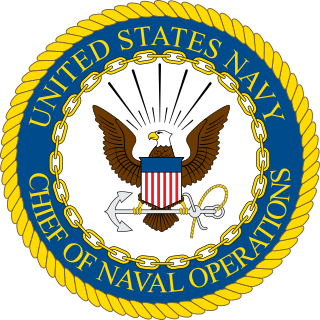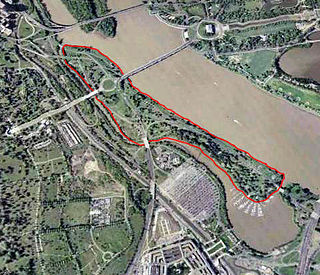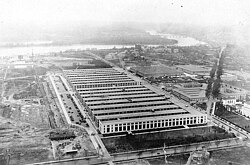
The chief of naval operations (CNO) is the highest ranking officer of the United States Navy. The position is a statutory office held by an admiral who is a military adviser and deputy to the secretary of the Navy. In a separate capacity as a member of the Joint Chiefs of Staff, the CNO is a military adviser to the National Security Council, the Homeland Security Council, the secretary of defense, and the president.

Moffett Federal Airfield, also known as Moffett Field, is a joint civil-military airport located in an unincorporated part of Santa Clara County, California, United States, between northern Mountain View and northern Sunnyvale. On November 10, 2014, NASA announced that it would be leasing 1,000 acres (400 ha) of the airfield property to Google for 60 years.

Woolwich Dockyard was an English naval dockyard along the river Thames at Woolwich in north-west Kent, where many ships were built from the early 16th century until the late 19th century. William Camden called it 'the Mother Dock of all England'. By virtue of the size and quantity of vessels built there, Woolwich Dockyard is described as having been 'among the most important shipyards of seventeenth-century Europe'. During the Age of Sail, the yard continued to be used for shipbuilding and repair work more or less consistently; in the 1830s a specialist factory within the dockyard oversaw the introduction of steam power for ships of the Royal Navy. At its largest extent it filled a 56-acre site north of Woolwich Church Street, between Warspite Road and New Ferry Approach; 19th-century naval vessels were fast outgrowing the yard, however, and it eventually closed in 1869. The former dockyard area is now partly residential, partly industrial, with remnants of its historic past having been restored.

The United States Department of War, also called the War Department, was the United States Cabinet department originally responsible for the operation and maintenance of the United States Army, also bearing responsibility for naval affairs until the establishment of the Navy Department in 1798, and for most land-based air forces until the creation of the Department of the Air Force on September 18, 1947.

The Naval History and Heritage Command, formerly the Naval Historical Center, is an Echelon II command responsible for the preservation, analysis, and dissemination of U.S. naval history and heritage located at the historic Washington Navy Yard. The NHHC is composed of 42 facilities in 13 geographic locations including the Navy Department Library, 10 museums and 1 heritage center, USS Constitution repair facility and detachment, and historic ship ex-USS Nautilus.

Lady Bird Johnson Park, formerly known as Columbia Island until 1968, is an island located in the Potomac River in Washington, D.C., in the United States. It formed naturally as an extension of Analostan Island in the latter part of the 1800s, and over time erosion and flooding severed it from Analostan, now known as Theodore Roosevelt Island. The U.S. federal government deposited material dredged from the Potomac River on the island between 1911 and 1922, and again from 1925 to 1927. The island was also reshaped by the government at this time "to serve as the western terminus of Arlington Memorial Bridge and a symbolic entrance into the nation’s capital." Located within the park are the Lyndon Baines Johnson Memorial Grove, Navy – Merchant Marine Memorial, and the Columbia Island Marina. The island, park, memorials, and marina are part of the George Washington Memorial Parkway and administered by the National Park Service.

Kiriwina is the largest of the Trobriand Islands, with an area of 290.5 km². It is part of the Milne Bay Province of Papua New Guinea. Most of the 12,000 people who live in the Trobriands live on Kiriwina. The Kilivila language, also known as Kiriwina, is spoken on the island. The main town is Losuia. The island falls under the administrative division of Kiriwina Rural LLG.

The Eisenhower Executive Office Building (EEOB), formerly known as the Old Executive Office Building (OEOB), and originally known as the State, War, and Navy Building, is a United States government building that is part of the White House compound in the U.S. capital of Washington, D.C. Maintained by the General Services Administration, the building currently houses the Executive Office of the President, including the Office of the Vice President of the United States. In 1999, the building was renamed in honor of Dwight D. Eisenhower, the 34th U.S. president and a five-star U.S. Army general who oversaw several military campaigns of the Allied forces during World War II.

Fagatogo is the downtown area of Pago Pago. Located in the low grounds at the foot of Matafao Peak, it was the location of the first American settlement on Tutuila Island. It includes the sub-village of Malaloa. Today, Fagatogo is the government, commercial, financial, and shipping center of Tutuila. It is also the administrative capital of American Samoa. It is the location of the American Samoa Fono (legislature), and is listed in the Constitution of American Samoa as the territory's official seat of government. Its population is 1,737.

Walter Reed National Military Medical Center (WRNMMC), formerly known as the National Naval Medical Center and colloquially referred to as Bethesda Naval Hospital, Walter Reed, or Navy Med, is a United States military medical center located in Bethesda, Maryland. It is one of the largest and most prominent military medical centers in the nation and has provided medical care for several U.S. presidents since its opening in 1940.

The Pentagon is the headquarters building of the United States Department of Defense, in Arlington County, Virginia, across the Potomac River from Washington, D.C. It was constructed on an accelerated schedule during World War II. As a symbol of the U.S. military, the phrase The Pentagon is often used as a metonym for the Department of Defense and its leadership.

The Brooklyn Navy Yard is a shipyard and industrial complex located in northwest Brooklyn in New York City, New York. The Navy Yard is located on the East River in Wallabout Bay, a semicircular bend of the river across from Corlears Hook in Manhattan. It is bounded by Navy Street to the west, Flushing Avenue to the south, Kent Avenue to the east, and the East River on the north. The site, which covers 225.15 acres (91.11 ha), is listed on the National Register of Historic Places.

The Harry S Truman Building is the headquarters of the United States Department of State. It is located in Washington, D.C., and houses the office of the United States secretary of state.

The Main Interior Building, officially known as the Stewart Lee Udall Department of the Interior Building, located in Washington, D.C., is the headquarters of the United States Department of the Interior.

Boundary Channel is a channel off the Potomac River in Washington, D.C. The channel begins at the northwestern tip of Columbia Island extends southward between Columbia Island and the Virginia shoreline. It curves around the southern tip of Columbia Island before heading northeast to exit into the Potomac River. At the southwestern tip of Columbia Island, the Boundary Channel widens into the manmade Pentagon Lagoon.

The Mary E. Switzer Memorial Building is a federally owned office building located at 330 C Street SW in Washington, D.C. in the United States. The Egyptian Revival structure was originally named the Railroad Retirement Board Building. It was designed by Charles Klauder and Louis A. Simon and completed on September 15, 1940. Although intended for the Railroad Retirement Board, its first occupant was to the United States Department of War. By Act of Congress, it was renamed the Mary E. Switzer Memorial Building on October 21, 1972, becoming the first federal building to be named for a woman.

The James V. Forrestal Building is a low-rise Brutalist office building in Washington, D.C. Originally known as Federal Office Building 5, and nicknamed the Little Pentagon, the Forrestal Building was constructed between 1965 and 1969 to accommodate United States armed forces personnel. It is named after James Forrestal, the first United States Secretary of Defense. It became the headquarters of the United States Department of Energy after that agency's creation in 1977.

The Navy Annex was a building near the Pentagon in Arlington, Virginia mainly used as offices for the United States Department of the Navy. The facility was also known as Federal Office Building 2. It was demolished in 2013 to make room for an expansion of Arlington National Cemetery and other uses.

The U.S. government constructed a number of temporary buildings on the National Mall during World War I and II which stood from 1918 until 1971. They were built due to the urgent need for office space during wartime, but they remained in use during peacetime even though they disrupted the intended layout of the mall according to the McMillan Plan for over half a century.

Naval Operating Base Terminal Island, was United States Navy base founded on 25 September 1941 to support the World War II efforts in the Pacific War. Naval Operating Base Terminal Island was founded by combining Naval Facilities in cities of San Pedro, Long Beach and Wilmington, California under one command. Much of the base was on the man-made Terminal Island, and harbor in San Pedro Bay. The harbor was made through the construction of a large breakwater system.






















